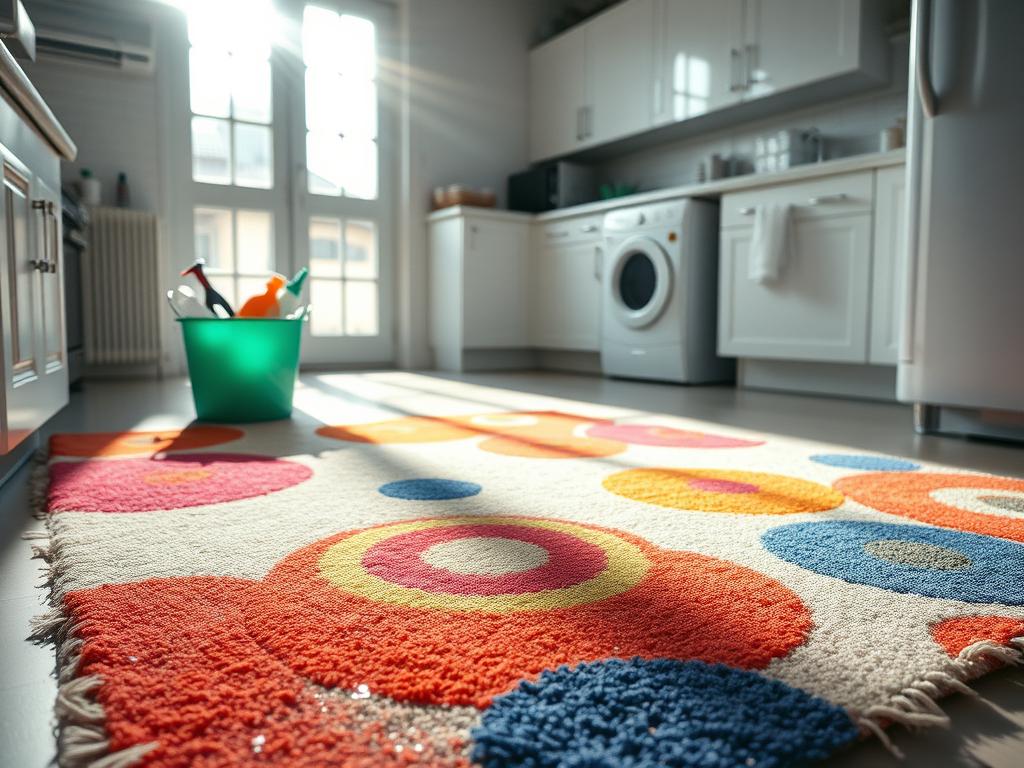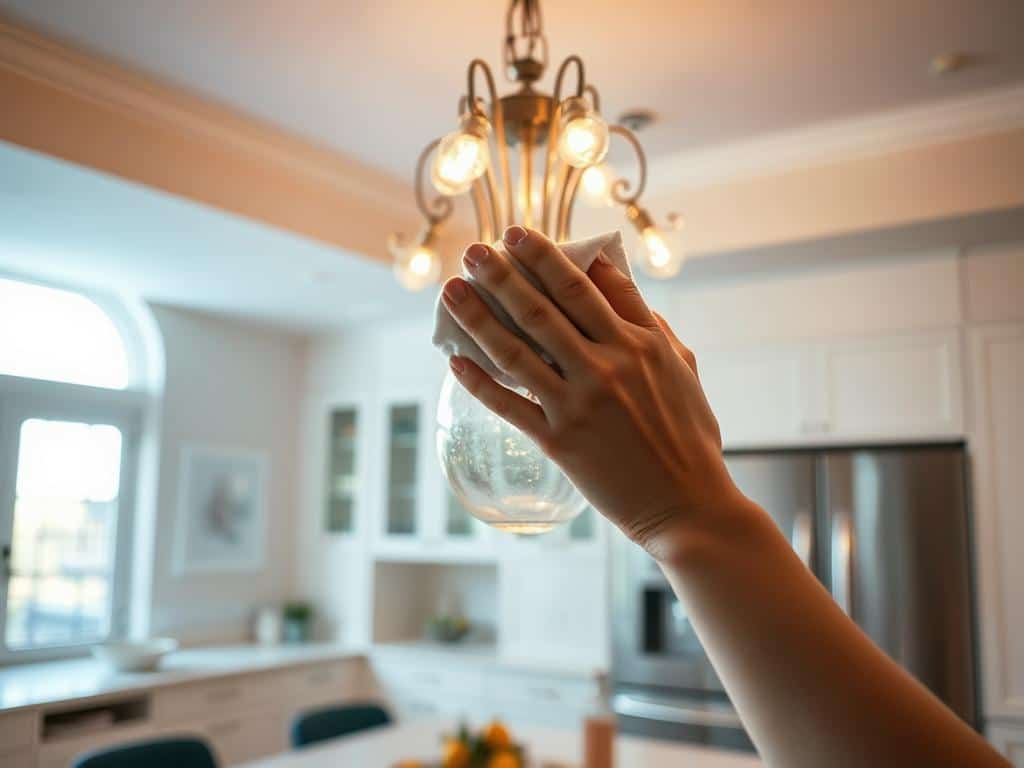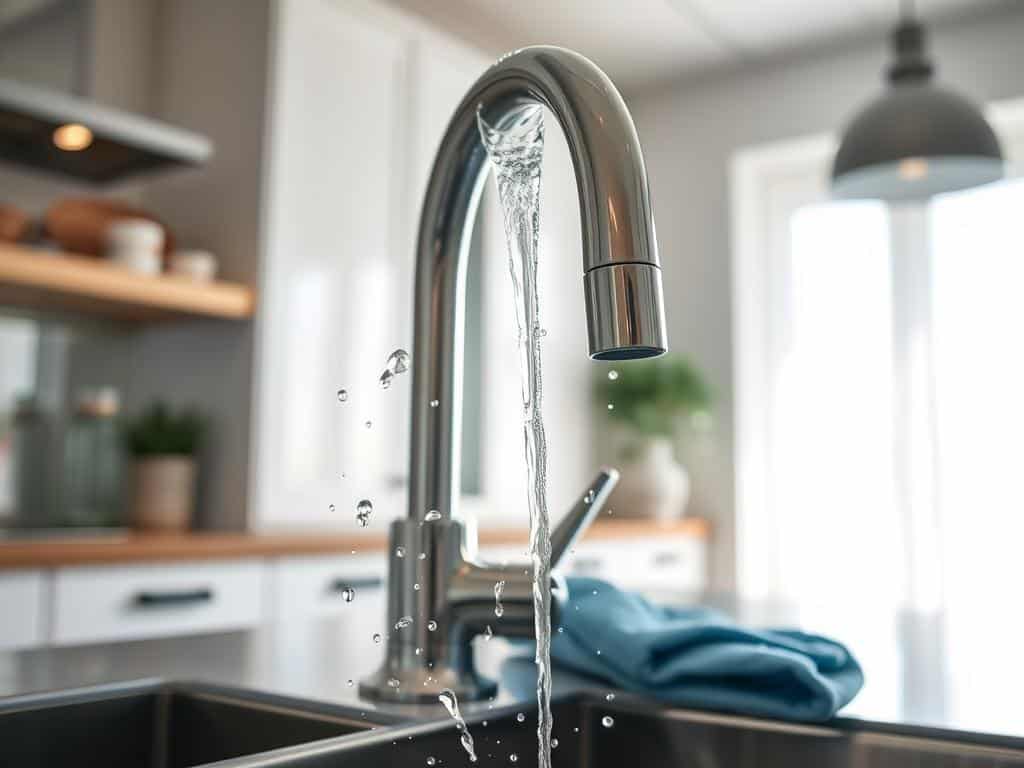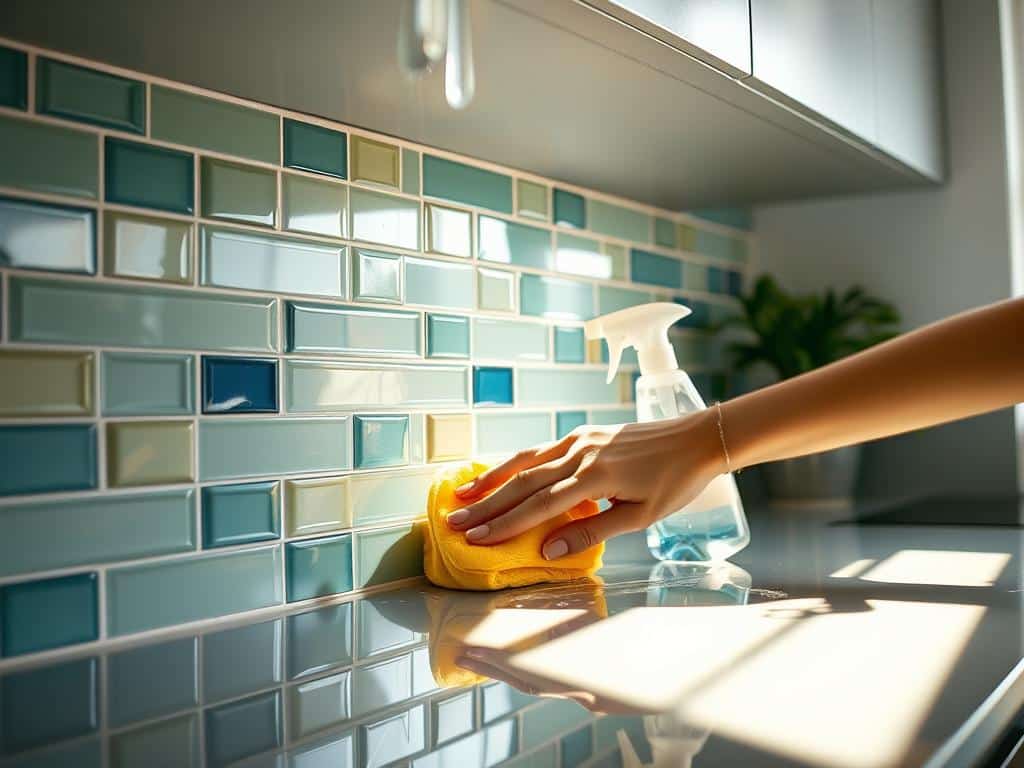
Maintaining a clean kitchen backsplash is essential for preserving the look and functionality of your kitchen. This crucial surface not only protects your walls from splashes and spills but also adds to the overall aesthetic of your space. Regular kitchen backsplash maintenance, including both daily wiping and periodic deep cleanings, can help prevent accumulation of stubborn stains, mold, and grease. Understanding how to clean your backsplash tile effectively with the proper tools and solutions, such as natural cleansers like baking soda and vinegar, is key to keeping it in pristine condition.
The choice of cleaning solution will depend on the material of your backsplash. For instance, ceramic or porcelain tiles are easily cleaned with hot water and an all-purpose cleaner, whereas glass tiles require non-abrasive cleaners to avoid scratches. Natural stone backsplashes, on the other hand, need to be treated gently to avoid damage from harsh chemicals. Effective tile backsplash cleaning involves understanding these nuances and selecting the right approach for each type of material.
Regular cleaning, especially after cooking sessions which often leave behind grease, is recommended. Immediate attention to grease spots and food splatters can make it easier to remove grease from tile backsplashes, preventing long-term buildup. With proper kitchen backsplash maintenance, your backsplash will remain an attractive and functional part of your kitchen for years to come.
Understanding Your Backsplash Material
Choosing the right cleaning methods for your kitchen backsplash starts with understanding the material used. From sturdy ceramic or porcelain tiles to sleek glass tiles and rustic natural stone or brick, each material demands specific care to keep it looking its best.
Ceramic or Porcelain Tile
Ceramic and porcelain tiles are popular choices for kitchen backsplashes due to their durability and ease of cleaning. Regular maintenance for these tiles is straightforward, often involving nothing more than a mix of dish soap and warm water. For porcelain backsplash care, a gentle approach ensures the tile retains its glossy finish. A paste of baking soda and water can be used for tougher grime, allowing it to sit for about 10 minutes before scrubbing. To maintain their appearance, avoid using abrasive cleaners that can scratch the surface.
Glass Tile
Glass tiles add a modern touch to any kitchen and are highlighted for their easy-to-clean properties. Simple wiping with a clean cloth and warm water is usually sufficient for glass tile maintenance, but care must be taken to avoid harsh scrubbing that can create scratches. For grease buildup, a mixture of vinegar and warm water can be an effective daily cleanser, preventing stains from setting in. Since glass tiles are non-porous and water-resistant, they resist most stains and are relatively low maintenance compared to other materials.
Natural Stone or Brick
Natural stone and brick backsplashes require more meticulous care due to their porous nature. Gentle, pH-neutral cleaners are essential for natural stone backsplash cleaning to prevent etching and damage. Dish soap mixed with warm water is typically safe, while some tougher stains might necessitate a degreaser like Goo Gone. Regularly wiping down the surface post-cooking helps in preventing stain buildup. Additionally, sealing natural stone helps in maintaining its water and stain resistance. For a comprehensive guide on cleaning and maintaining your backsplash tiles, check out these cleaning tips.
Essential Cleaning Tools and Solutions
Maintaining a pristine kitchen backsplash not only enhances the aesthetic appeal of your cooking space but also ensures a healthy environment. From tailored commercial cleansers to good old soap and water, the right approach can make all the difference. Here’s a comprehensive guide to the essential tools and solutions for effective backsplash cleaning.
Commercial Cleansers
For a high-performance clean, commercial kitchen tile cleansers are your best bet. These products are specifically formulated to target grease, grime, and food splatters without causing harm to your tiles or grout. Look for pH-neutral and abrasive-free options to avoid damaging the surface. Brands like Method and Seventh Generation offer eco-friendly backsplash cleaners that perform exceptionally well while being gentle on your surfaces. Use these regularly, especially after heavy cooking sessions, to maintain your kitchen’s sparkle.
Soap and Water
One of the simplest and most effective cleaning solutions is a mixture of warm water and mild soap. Ceramic tile backsplashes, for example, often just require this basic solution. Simply moisten a soft cloth, wipe down the tiles, and rinse with clean water. This method is effective for daily upkeep and can prevent grime buildup, ultimately saving you from more intensive grout cleaning later on. If your backsplash is glass, consider using a glass cleaner to avoid water spots and maintain that pristine look.
Natural Cleansers
If you’re searching for eco-friendly options, natural cleansers such as baking soda, vinegar, and lemon juice are exceptional. These ingredients are not only safe for children and pets but also highly effective against stubborn stains and grease. A DIY vinegar and water solution, for instance, can cut through greasy spots and add shine to your backsplash. Lemon juice can help with deodorizing while also tackling hard water stains. To maximize efficiency, regular wiping down of the backsplash after cooking is recommended.
For a deeper dive into maintaining and cleaning delicate surfaces, you might find this expert guide helpful.
How to Clean Kitchen Backsplash
Maintaining a pristine kitchen backsplash involves a combination of consistent routines and the appropriate cleaning techniques. This section breaks down the essential steps for daily, weekly, and monthly cleaning, culminating in methods to tackle stubborn stains.
Daily Cleaning Routine
A daily cleaning routine is key to effective kitchen backsplash upkeep. Consistently wiping down the backsplash with a mild cleaner or soapy water prevents buildup and makes deep clean tiles less daunting. Daily attention not only keeps your kitchen looking fresh but also extends the life of your backsplash, regardless of the material.
Tools needed for daily routine include:
- Sponge
- Dish soap
- Dish cloths
Using a soapy sponge, clean the tile and grout with circular motions, then wipe with a damp cloth to remove soap residue. This process is effective in addressing light spills and grease spots found in common cooking areas.
Weekly and Monthly Deep Cleaning
Weekly and monthly deep clean tiles sessions ensure comprehensive maintenance by tackling accumulated grime that daily routines may miss. For grout lines, a toothbrush and a mix of water and white vinegar work well, while a commercially available cleaner like the Method Heavy Degreaser, rated 4.5/5, excels for persistent grease. Additionally, sealing tiles annually offers optimal protection against damage.
Recommended items for deeper cleaning include:
- Toothbrush
- Grout sealer
- Vinegar
- Baking soda
- Method Heavy Degreaser
| Cleaning Method | Rating | Price |
|---|---|---|
| Vinegar and Water Solution | 3.5/5 | Negligible |
| Magic Eraser | 4/5 | $6.99 (pack of six) |
| E-cloth | 4/5 | $4.79 |
| Method Heavy Degreaser | 4.5/5 | $4.99 |
| Dawn PowerWash | 5/5 | N/A |
Dealing with Stubborn Stains
Stubborn stains can be a challenge, but they’re not impossible to remove. A paste of baking soda and water applied to tough spots, followed by a wipe-down with a vinegar solution, effectively removes kitchen stains. For grease-heavy areas, particularly behind the stove, the Dawn PowerWash method rated at a perfect 5/5 for performance, is especially effective.
When working with porous materials such as stone, specialized stone cleaners and gentle brushing are necessary to avoid damage. Always inspect for any signs of wear or damage to prevent moisture issues from escalating into mold growth.
For stubborn stains, it’s essential to use the right techniques:
- Apply a DIY paste of baking soda and water on the stain.
- Brush gently with a toothbrush.
- Wipe with a vinegar solution.
Following these steps ensures that even the toughest stains are handled, keeping your kitchen backsplash pristine and hygienic.
Maintaining and Extending the Life of Your Backsplash
Ensuring the backsplash longevity in your kitchen goes beyond routine cleaning. It requires understanding the specific needs of your backsplash material, committing to regular tile sealing, and diligently performing grout care. By addressing these aspects, you can maintain both the appearance and functionality of your backsplash, ultimately extending its lifespan.
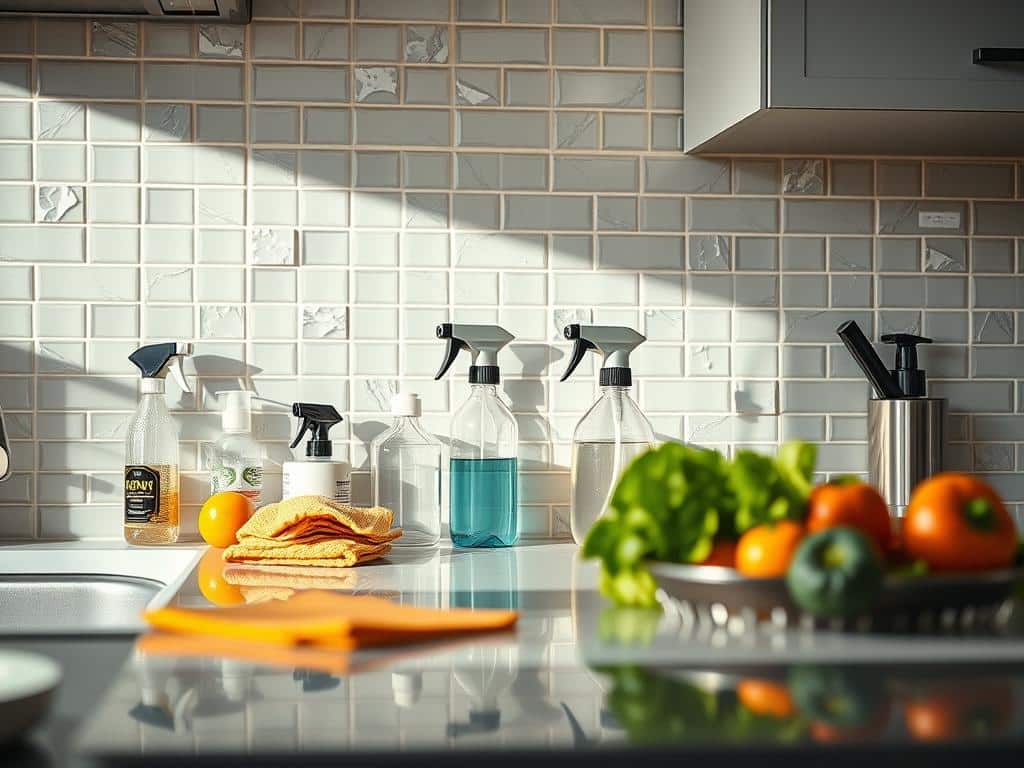
Regular cleaning can significantly extend the lifespan of your kitchen backsplash by preventing damage from acidic foods or harsh chemicals over time. For instance, glass splashbacks benefit from the use of natural or gentle cleaners to avoid scratches and surface damage. Incorrect cleaning products may cause long-term damage or discoloration to your backsplash.
Sealing the grout between tiles is a crucial step in backsplash maintenance. This prevents mold buildup and protects against wear. To maintain proper tile sealing, it’s recommended to reapply sealant annually. Thoroughly cleaning grout lines before applying sealant ensures effective penetration and durability. Using a roller applicator to spread sealant evenly across the entire backsplash provides thorough coverage and a durable seal.
For large backsplashes, consider dividing the surface into manageable sections during the sealing process to prevent the sealer from drying prematurely. Multiple coats may be necessary, especially for porous tiles, to create a thick barrier against water in high-traffic areas. Regular maintenance, including occasional washing with mild detergent and reapplying sealant as needed, can significantly prolong the durability of your backsplash.
Investing in high-quality tools such as a silicone squeegee is a convenient option for busy homeowners, while using microfiber cloths ensures a scratch-free shine, especially on stainless steel splashbacks. Additionally, using a squeegee on glass surfaces is effective in removing water marks without leaving streaks.
- Mix vinegar and water in equal parts for an effective all-purpose cleaner.
- Choose the appropriate sealer based on your tile type: solvent-based for ceramic tiles, and penetrating sealer for natural stone.
- Always seek advice from professional contractors for significant grout issues or when installing new tiles.
By following these preventive maintenance steps, you can keep your backsplash not only as a protective component but also as a source of pride in your kitchen. Regularly inspecting for damage and making timely repairs ensures safety and sustains the backsplash’s appearance, contributing to its backsplash longevity.
Conclusion
In conclusion, ensuring the cleanliness and upkeep of your kitchen backsplash is vital to both the protection of your walls and the overall aesthetic of your kitchen. Understanding your backsplash material, from glass to ceramic tiles or natural stone, enables you to apply the best cleaning methods, prolonging its durability and visual appeal. Daily maintenance routines, such as wiping down tiles and promptly addressing grease and food spills, are essential in high-traffic areas like behind the stove and sink.
Utilizing the right cleaning tools and solutions, whether commercial products or natural mixes like vinegar and water, enhances the cleaning process significantly. For regular cleaning, combining a few drops of dish soap with warm water effectively handles everyday dirt. For those tougher stains, a paste of baking soda and water can work wonders. Additionally, it’s important to periodically clean the grout between tiles to maintain a consistent look and prevent grime build-up.
By incorporating these kitchen backsplash tips into your routine, not only do you enhance the functionality and style of your backsplash, but you also simplify its upkeep. Choosing glazed tiles can provide an extra layer of protection, while handmade tiles offer beautiful natural variations. Remember, quick action on spills, using effective yet gentle cleaning solutions, and avoiding abrasive tools will make a notable difference in your kitchen’s appearance and longevity. Following this backsplash cleaning guide ensures a cleaner, more inviting kitchen space, reducing effort and increasing satisfaction.

